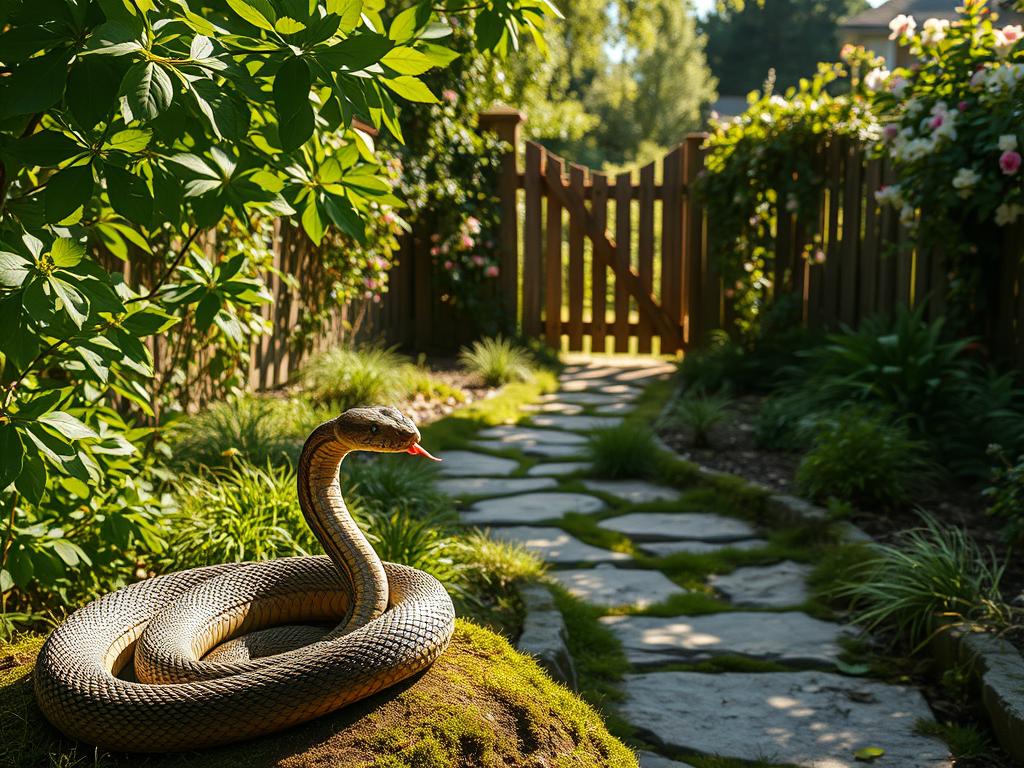Everyone dreams of having a beautiful yard for outdoor fun. While some animals might want to join us, we can keep unwanted visitors out. Meg Pearson, a wildlife expert, says, “Tall grass hides snakes from predators,” so keeping our lawns short is key.
Having a snake-free yard is more than just looks; it’s about safety too. Knowing what mistakes attract snakes helps us snake-proof our yard. Simple steps can greatly reduce the chance of snakes showing up.
We can enjoy our yards without fear of snake infestations. This article will show you the common mistakes that might attract snakes. We’ll also share tips to keep them away.
Why Snakes Are Attracted to Residential Gardens
Residential gardens can become snake havens due to various factors. These factors cater to their survival needs and behavior. Snakes play a crucial role in maintaining a balanced ecosystem. With approximately 150 species found in North America, most of which are non-venomous, they are essential to our environment.
Natural Snake Behavior and Survival Needs
Snakes are attracted to areas that provide shelter, food, and suitable habitats. Residential gardens often unintentionally offer these necessities. This makes them appealing to snakes. For instance, gardens with dense vegetation, rock piles, or wood features can provide snakes with hiding spots and ambush points.
- Dense ground cover and overgrown vegetation
- Rock and wood features
- Poorly designed water features
Identifying Common Snake Species in American Gardens
In North America, some of the most common snake species found in gardens are non-venomous and beneficial for pest control. These include garter snakes, king snakes, and rat snakes. Understanding the types of snakes that inhabit your garden can help you take steps to deter them or coexist with them.
- Garter snakes
- King snakes
- Rat snakes
By understanding why snakes are attracted to residential gardens, we can take steps to prevent them from inhabiting our outdoor spaces. In the next section, we will discuss common mistakes that invite snakes into your garden.
Common Mistakes That Invite Snakes Into Your Garden
Gardens can become snake havens if we neglect them. We often unknowingly create a welcoming space for snakes. It’s key to understand these mistakes to keep our yards snake-free.
One big mistake is ignoring potential snake hiding spots. Snakes seek shelter and cover. Yards with woodpiles, debris, or clutter attract snakes. Keeping your yard clean and free of clutter is vital. Critter Control experts say removing hiding spots is a top snake prevention tip.
Overlooking Potential Snake Hiding Spots
Snakes hide in tall grass, under rocks, or in woodpiles. To stop them from making your garden their home, eliminate these spots. Regular lawn care and trimming can help. Also, storing woodpiles and debris in sealed areas or removing them can make your garden less appealing to snakes.
Experts say, “a clean yard is a snake-free yard.” By removing clutter and debris, you can greatly reduce snake invasions. This is a simple yet effective snake-repelling strategy for homeowners.
Creating Unintentional Food Sources for Snakes
Another mistake is creating food sources for snakes. Snakes are drawn to areas with lots of rodents and pests. To avoid snake infestation, it’s crucial to control pests. Seal entry points, remove food sources, and use humane pest control methods.
Snakes are attracted to yards with rodent infestations. By controlling pests, you can lower the chance of snakes visiting your garden. Effective pest control is a key step in maintaining a snake-free yard.
Problematic Landscaping Choices That Create Snake Havens

The way we landscape our outdoor spaces can either welcome or deter snakes. Some landscaping choices can create snake havens. It’s important to know what attracts these reptiles to our gardens.
Dense Ground Cover and Overgrown Vegetation Issues
Dense ground cover and overgrown vegetation offer snakes plenty of hiding spots. Tall grass, weeds, and dense shrubs can become snake-friendly if not kept in check. To avoid this, keep grass short and trim vegetation regularly.
Improper Placement of Rock and Wood Features
Rock piles and wood piles can serve as shelters for snakes. They provide shelter and potential prey. When placing these features, consider their distance from our homes and other areas where snakes might be unwanted. Sealing gaps and crevices can help keep snakes away.
Poorly Designed Water Features That Attract Snakes
Poorly designed water features, like ponds or fountains, can attract snakes. They provide water and attract prey like frogs or fish. Design water features with snake control in mind, using snake-repellent plants or fencing.
By making smart landscaping choices, we can reduce snake habitats in our yards. This includes keeping grass short, removing debris, and designing water features with care. These steps help create a snake-resistant garden, making it safer and more enjoyable for everyone.
Yard Maintenance Oversights That Welcome Reptile Visitors

Many homeowners don’t realize they’re inviting snakes into their gardens. Snakes are drawn to places with shelter, food, and a good environment. Knowing the mistakes that attract snakes helps homeowners keep their gardens snake-free.
Tall grass and weeds give snakes a safe place to hide. Keeping your lawn short and tidy is key to keeping snakes away.
Infrequent Lawn Mowing and Trimming Practices
Not mowing or trimming your lawn often leads to overgrown areas. These areas attract snakes. A well-kept lawn makes your garden less appealing to snakes.
Regular lawn care not only looks better but also keeps snakes away. It removes hiding spots and makes snake habitats less likely.
Accumulated Garden Debris and Yard Clutter
Yards with debris or clutter attract snakes. These areas offer shelter and food. Keeping your yard clean and free of clutter helps avoid attracting snakes.
Clearing away garden debris and yard clutter is an easy way to deter snakes. This includes getting rid of old pallets and broken machinery that snakes might hide in.
Improper Compost and Mulch Management
Bad compost and mulch management can also draw snakes. These can attract rodents and other small animals. Proper management of compost and mulch reduces snake attraction.
To keep snakes away, manage your compost and mulch well. This means keeping compost piles tidy and turning the material often. Also, use mulch that’s less appealing to wildlife.
By avoiding these common mistakes, homeowners can make their gardens snake-proof. A well-kept lawn, a clean yard, and proper compost and mulch management all help. These steps reduce the chance of attracting snakes and keep your garden safe.
Structural Issues and Pest Problems That Attract Snakes
To keep snakes away, it’s key to fix any structural problems and pest issues in your garden. Snakes often sneak into homes and gardens through small openings. It’s important to seal any gaps or holes.
Unsealed Gaps in Home Foundations and Structures
Snakes can get into your home through gaps in the foundation, broken siding, or vents. To stop this, check your home’s outside and seal any cracks or openings. Use steel wool or caulk for this.
Look for gaps around pipes, vents, and doors. These spots are common entry points for snakes.
Neglected Outbuildings and Storage Areas
Outbuildings, sheds, and storage areas can attract snakes if they’re not kept clean. Keep these places tidy and well-maintained. This will discourage snakes from living there.
Regularly check these areas for snake signs, like shed skins or droppings.
Rodent Infestations That Draw Predatory Snakes
Rodent infestations can attract snakes because they prey on these small animals. To keep snakes away, manage rodent infestations well. Seal entry points, remove food sources, and use humane traps or repellents.
By fixing these issues, we can make our gardens less appealing to snakes. This makes our outdoor spaces safer and more enjoyable for everyone.
Conclusion: Creating a Snake-Resistant Garden Environment
Homeowners can make their gardens less appealing to snakes by avoiding common mistakes. Keeping your yard clean and tidy is key. Also, sealing any holes and managing pests helps a lot.
Removing things like debris, rocks, and woodpiles can keep snakes away. Using plants that repel snakes and keeping rodents out also helps. These steps can make your garden less welcoming to snakes.
Identifying and removing snake hiding spots is crucial. This includes dense plants and overgrown areas. By doing this, you can make your outdoor space safer and more enjoyable.
By using these simple methods, you can keep your yard snake-free. This reduces the chance of unwanted reptiles showing up.






